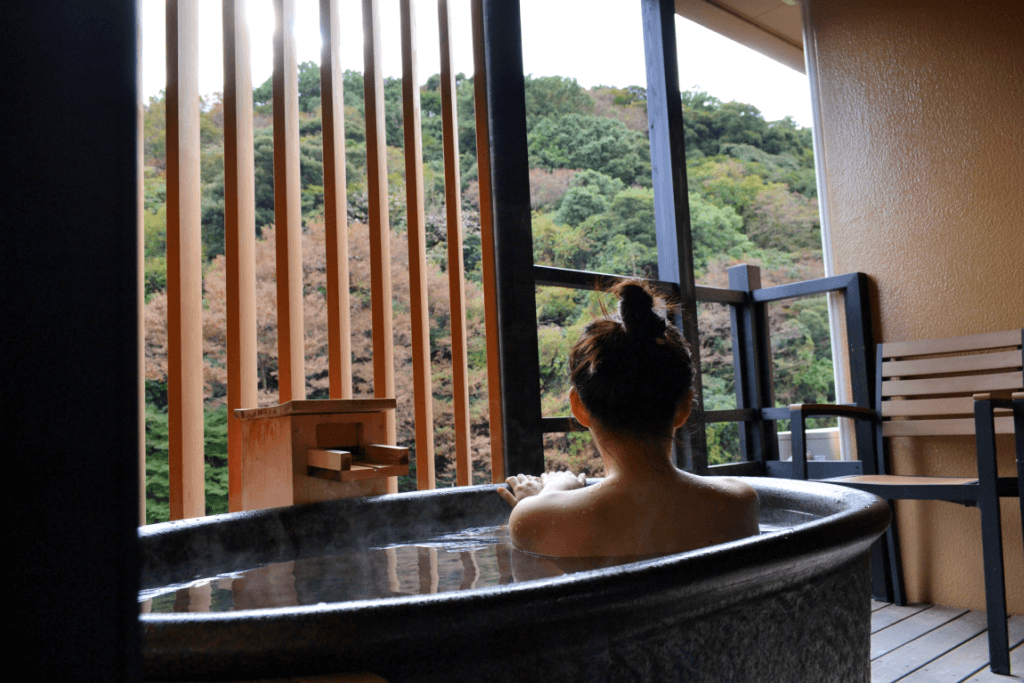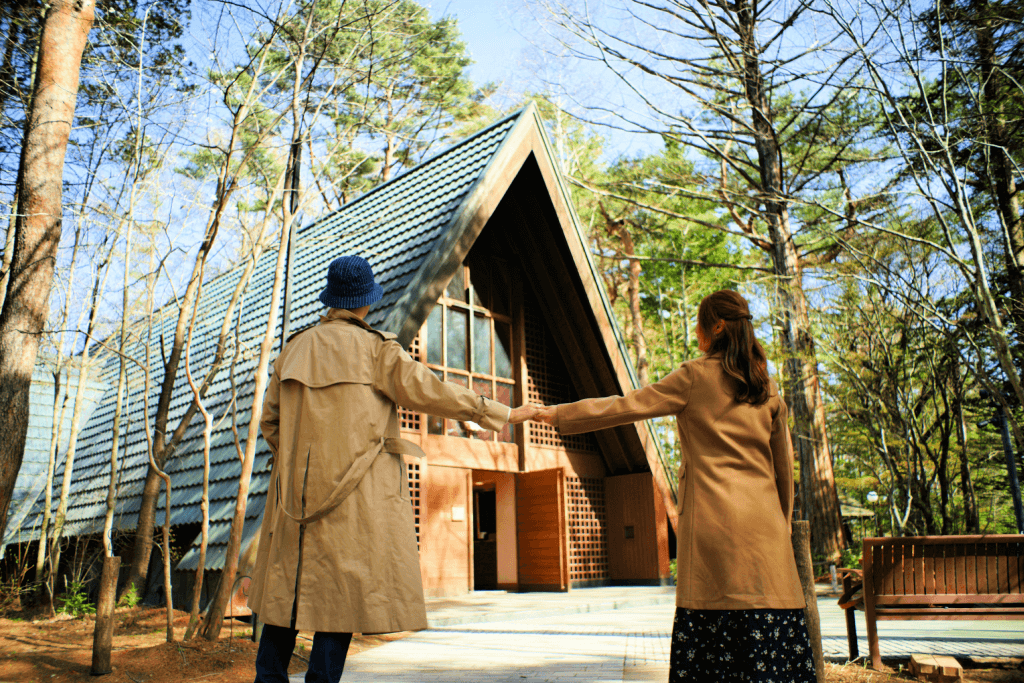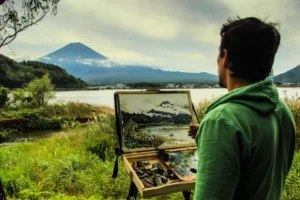Japan has no shortage of romantic cities, with Hakone (Hakone machi, 箱 根) at the top of the list. It’s the perfect destination for couples, home to beautiful landscapes, well-preserved historical landmarks, and comfortable hotels. So, we’ve put together these recommendations based on historical importance, natural beauty, and tourist activities. Join us as we travel to Hakone and other romantic locations in Japan!
Table of Contents
ToggleHakone (Kanagawa Prefecture)
Hakone Ginyu
Generally, this delightful ryokan offers rooms with tatami mat floors and breathtaking mountain views. Moreover, guests can wear yukatas, taste local cuisine, and enjoy the public bath or private onsen from a natural hot spring. Access is available via the Hakone Tozan train, which is only a three-minute walk from the Miyanoshita train station.

Hakone Shrine
Built to honor Hakone Daigongen, the god of good fortune, this Shinto shrine is also found near Lake Ashi. Its museum contains statues, swords, and ema (wooden prayer plaques). Moreover, the shrine hosts several festivals throughout the year. From Hakone Yumoto Station, it’s a 35-minute bus ride to the Moto Hakone Pier and then 5-10 minutes by foot.
Fujiya Hotel
One of Japan’s first resort hotels, Fujiya Hotel combines traditional Japanese and contemporary Western styles. Nearby attractions also include the Hakone Open Air Museum, Hakone Gora Park, and the Hakone Sightseeing Cruise featuring pirate ships. Moreover, they can be accessed from Gora Station, seven minutes away by train or cable car. Fujiya Hotel is also a two-minute walk from the nearest bus stop.
Kyoto (Kyoto Prefecture)
Garden Museum Hiei
Here, you can pretend you’re stepping inside a painting at this fantastic open-air museum. This is because the Garden Museum Hiei showcases Impressionist art with gardens (including a replica of Monet’s “Water Lilies”) and ceramic tile copies of famous paintings. There’s also a Parisian café and a gift shop.

Kyoto Aquarium
Located in Umekoji Park, the Kyoto Aquarium has 12 exhibits highlighting aquatic species, including the giant salamander native to Kyoto’s rivers. Not to mention, the Dolphin Stadium and the Cape Penguin enclosure are the most popular exhibits. While more crowded, the Kyoto Aquarium is worth the visit.
Shimogamo Shrine
Afterward, you can pay your respects at Shimogamo Shrine, one of Japan’s oldest Shinto shrines. Paired with the Kamigamo Shrine, the UNESCO World Heritage Site is located in the Tadasu no Mori (Forest of Purification) near Mitarashi Pond, said to have purifying waters. It’s also one of the stops for the Aoi Matsuri parade, held on May 15.
Himeji (Hyogo Prefecture)
Himeji Castle
Also called Hakuro-jo (White Heron Castle), Himeji Castle is Japan’s most significant and most-visited castle. One of the country’s first UNESCO World Heritage Sites, it’s a wonder to behold with 83 buildings, well-kept paths, and spectacular views from the top. The best time to visit is early April, when the cherry trees bloom.

Koko-en Garden
Near Himeji Castle, Koko-en Garden is built on the former site of the lord’s western palace. Spanning 8.6 acres and divided into nine smaller sections, Koko-en Garden has artful landscaping and well-preserved Edo-period buildings. It also hosts excellent public events, including tea ceremonies and tsukimi (moon-viewing) festivals.
Mount Shosha
To experience more of Himeji’s nature, visit Mount Shosha in Seiban Kyūryō Prefectural Natural Park. Designated as a wildlife sanctuary, it has also been used as a filming location. Finally, at the top is the Shoshazan Engyō-ji Temple, home to several historic buildings.
Are you looking for some delicious snacks for Valentine’s Day? Check out Sakuraco! Sakuraco delivers traditional Japanese snacks, teas, sweets, and snacks from Japan to your door every month so that you can enjoy Japan’s taste anywhere!
Itoshima Peninsula (Fukuoka Prefecture)
Sakurai Futamigaura Beach
If you and your loved one have a wedding coming up, you should visit Sakurai Futamigaura Beach. Behind the white torii gate, the Meteo Iwa (wedded rocks) rise from the water connected by a shimenawa (Shinto straw rope). While a stunning beach, it’s also the perfect place to ask for blessings and a happy marriage.

Shiraito Falls
With a height of 24 meters and a width of 14 meters, Shiraito Falls is a sight to behold, especially during its Hydrangea Festival and Golden Week. Visitors can try fishing for yamame trout and making nagashi somen (flowing noodles). Fun fact: Karuizawa in Nagano Prefecture also has a waterfall by the same name.
Palm Tree Swing
The Palm Tree Swing is one of Itoshima’s most iconic spots in Karuizawa. Because of this, visitors can imagine themselves in the tropics enjoying the sea breeze and waves lapping on the shore. After taking pictures, couples can order a romantic meal at the nearby Zauo Itoshima Honten.
Karuizawa (Nagano Prefecture)
Karuizawa Kogen Church
First opened in 1921 as a Liberal Arts school, Karuizawa Kogen Church has hosted Christian and non-Christian weddings since 1965. The simple chapel is also surrounded by trees, which offer shade and gorgeous pictures in all seasons. Its beauty is also highlighted through light displays after dark.

Karuizawa Wild Bird Sanctuary
Open since 1974, this sanctuary contains 247 acres of forestland, two miles of trails, and over 80 species of primarily rare birds, as well as butterflies and musasabi (giant flying squirrels). The Picchio Visitor Center offers several different tours, but visitors can also walk independently for a more private experience.
Kumoba Pond
Twenty minutes from Karuizawa Station is the breathtaking Kumoba Pond. A short 20-minute walk, the best views are in the fall with the changing leaves. It is also famous for bird watching and is even called Swan Lake after the swans that visit in the winter.
What makes Hakone and other Japanese cities so romantic?
One commonality between these Japanese cities is their natural beauty, from Hakone’s mountain views to Itoshima’s seascapes. Moreover, they are also home to historical sites either in their original state or restored with painstaking care. Visitors can appreciate the ambiance of both while taking care to respect them.

Japanese hotels, especially those in Hakone, offer countless amenities and opportunities for foreign guests to experience the local culture. Finally, these cities contain a mixture of fast-paced activities and chances for slower, more intimate moments that everyone can enjoy. Have you visited Hakone or any of these other cities? Do you have any recommendations for romantic getaways in Japan? Tell us in the comments below.











